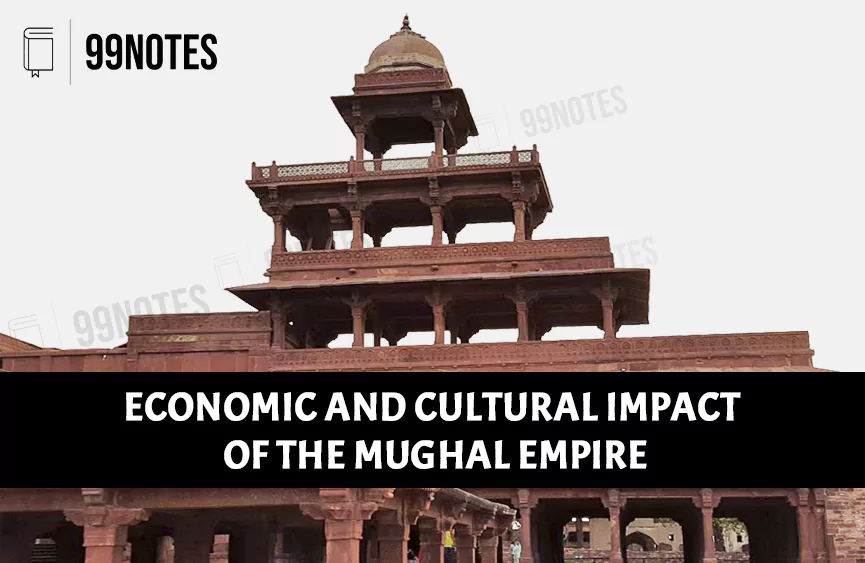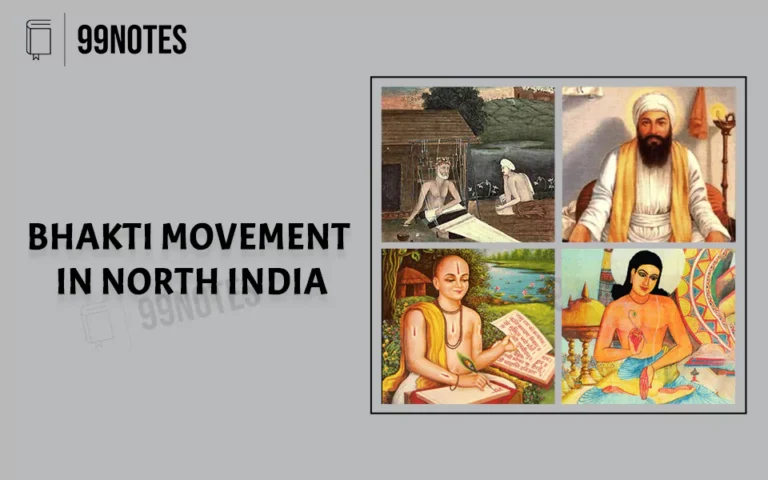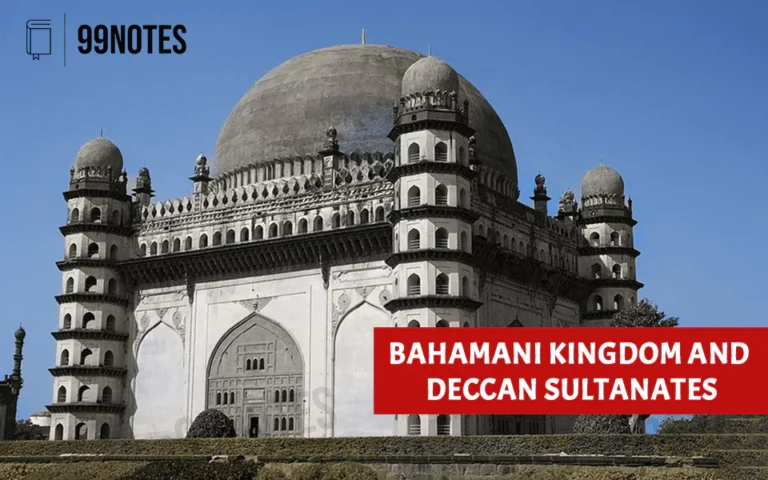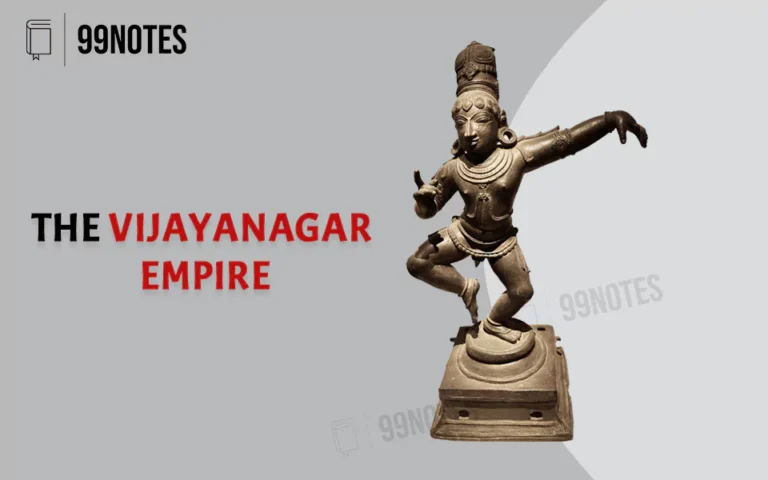Economic and Cultural Impact of the Mughal Empire
Mughal Economy
The Indian economy was strong till the Mughal times. By 1700, India’s share of world GDP was 24%, the largest in the world, larger than any other region. India, then, was producing about 25% of the world’s industrial output up until the 18th century.
Agriculture
- During the Mughals, large tracts of land were freshly brought under Agriculture, a process that was continued till Aurangzeb. This led to the expansion of the economy and brought revenue to the Empire.
- A large variety of crops were cultivated, such as:
- Food grains such as Wheat, rice, gram, barley, pulses, bajra, etc., were cultivated.
- Cash crops such as cotton, sugarcane, oil seeds, indigo and chay (the red dye) were also cultivated.
- American-origin crops: In the seventeenth century, two new crops were added, Maize and Tobacco.
- Silk cultivation became so widespread in Bengal that there was no need to import from China.
- India also exported agricultural products like rice and sugar to some of the neighbouring countries.
- The state also provided incentives and agricultural loans (Taccavi) to the peasants to expand and improve cultivation.
- Taxation/Land Revenue: However, by the end of the 17th century, the economic situation of the peasantry was in turmoil due to the high rate of taxes. The revenue from the peasantry could go even above 50% in some areas, and as high as 25% of the total produced could be appropriated by the Zamindars alone.
Mughal Currency
- Coins of three metals, copper, silver and gold, were minted. However, the silver coin was the base of the currency.
- Akbar continued the silver currency Rupaya introduced by Sher Shah Suri. It was the principal coin used for business and revenue transactions.
- A gold coin called Ashrafi or Muhr was issued during this period. However, it was mainly issued for hoarding and gifting purposes.
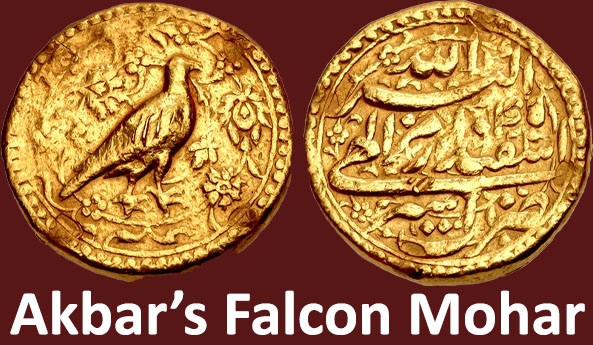
- Dam, a copper coin, was the most commonly used coin in the Empire.
- In coastal areas, sea shells or kauris were also used for petty transactions.
Trade and commerce
- The Banjaras, a class of traders, specialised in carrying bulk goods over long distances.
- Sugar, rice, delicate Muslin and Silk were exported from Bengal.
- Coromandel Coast had become an important centre for textile production, and Lahore was a centre of handicraft production.
- Hundis is a letter of credit used for the easy transmission of money from one place to another.
- Nagarseth was the leader of the merchant class who would intercede with the officials on their behalf. We also hear about hartals by merchants in order to express their point of view.
- Foreign trade also flourished during the seventeenth century, leading to an increase in the import of silver and gold into the country.
- Political integration and establishing law and order in the Empire helped expand trade and commerce during the seventeenth century.
Mughal Society
- The account of foreign travellers indicates that there was a great deal of inequality in the villages.
- The landless peasants or labourers often belonged to the caste of untouchables or ‘Kamin’.
- The Khudkasht, or the landowners, often belonged to a single dominant caste or class and exploited the ‘Kamins’. In turn, they themselves were exploited by Zamindars.
- In the cities, the large section consisted of artisans, soldiers, manual workers etc.
- The Mughal nobility formed a privileged class, both socially and economically.
- Initially, the bulk of Mughal nobility was drawn from Mughal homelands such as Uzbekistan, Iran and the neighbouring areas.
- During Akbar’s reign, Hindus also began to be inducted regularly.
Mughal Art and Architecture
- Mughal architecture is known for large bulbous domes, narrow minarets at the corners, massive halls, large vaulted gateways, and delicate ornamentation.
- It took influence from preceding Islamic architecture in India along with Iranian and Central Asian architecture and Hindu
- Running water in and around palaces and gardens was a special feature of Mughal architecture.
- Charbagh style (quadrilateral garden layout) was introduced in India by the Mughals.
- The famous gardens they built are Nishat Bagh in Kashmir,
- the Shalimar Bagh in Lahore and the
- Pinjore Garden in Punjab.
- Humayun’s Tomb in Delhi
- Taj Mahal of Agra

Charbagh style (HUMAYUN TOMB)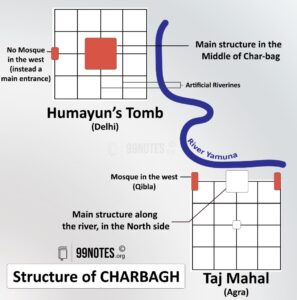
- During this period, Sher Shah Suri built Purana Qila and his tomb at Sasaram, Bihar.
- Large-scale construction of Mughal architecture started during Akbar’s reign.
- He built forts at Agra and Lahore and the city of Fatehpur Sikri to commemorate his victory over Gujarat. Here we see the magnificent Buland Darwaza.
- We also see the influence of the Jain architecture of Dilwara in the carvings here.
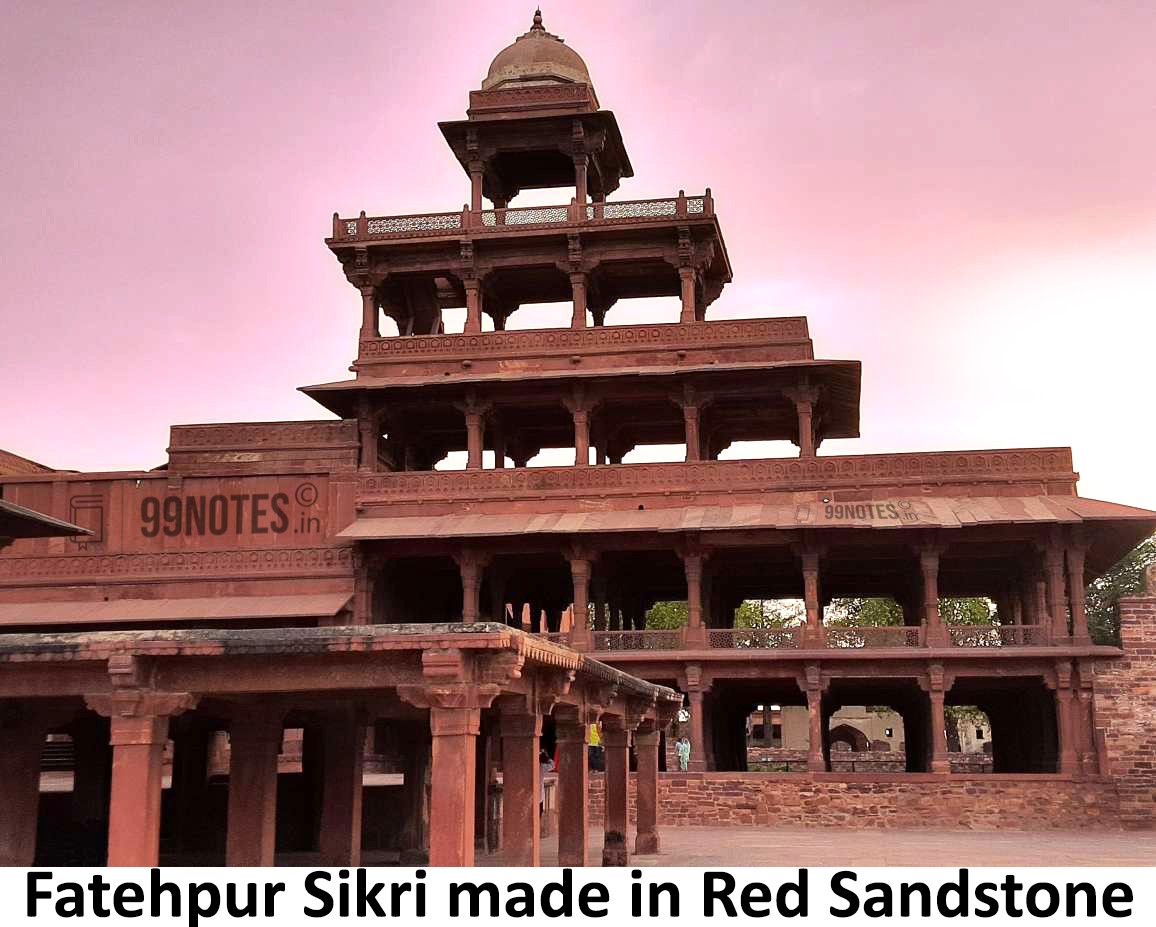
- Shah Jahan built the famous Red Fort in Delhi.
- He used the Pietra dura (floral designs with semi-precious stones) system in his architecture, which can be seen in the marvellous Taj Mahal.
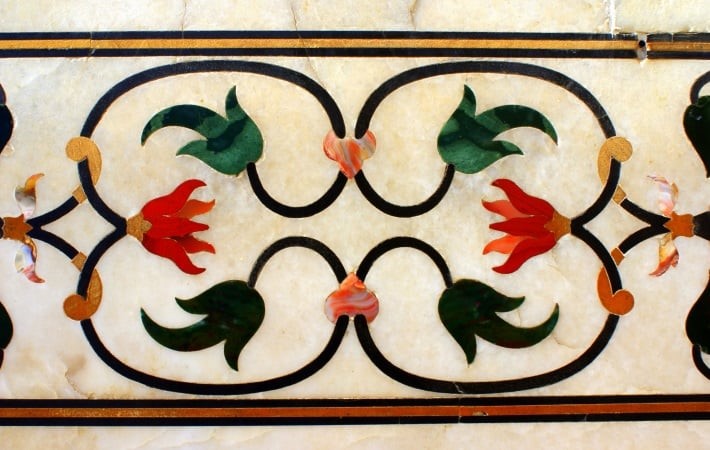
Pietra dura of Taj mahal
- The mosque building reached its climax during Shah Jahan. He built Moti Masjid entirely in white marble in Agra Fort and the Jama Masjid in red sandstone in Delhi.
- Aurangzeb did not put up many buildings. He built Badshahi mosque and Biwi ka Makbara (a poor imitation of the Taj Mahal).

Biwi ka Makbara
- Mughal features of architecture influenced the palaces and forts of many provincial and local kingdoms. Even the Golden Temple at Amritsar incorporated several Mughal elements.
- Developments in the field of Music took place.
Mughal Art
1. Mughal Paintings
- The Mughal painting evolved from the Persian school of miniature painting with Hindu, Buddhist and Jain influences.

- The themes of Mughal paintings usually revolved around battle scenes, hunting, royal life etc.
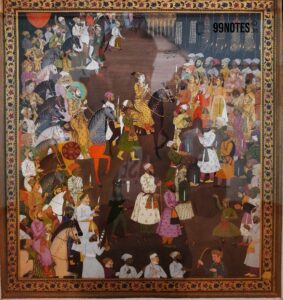
- Akbar set up a painting workshop in the royal establishment (Karkhana). Daswant and Basawan were two famous painters of Akbar’s court.
- Mughal painting reached its climax during Jahangir’s reign. Portrait paintings and paintings of animals were special features during his reign.
- During Akbar’s time, the principle of foreshortening was adopted, whereby near and distant people and things could be placed in perspective. This was influenced by European paintings.
- Mughal paintings declined under Aurangzeb’s rule, and artists migrated to other places, Rajasthan and Punjab, where regional schools of painting developed.
- Aurangzeb’s successors revived the Mughal tradition of painting.
2. Music during Mughal period
- Classical Hindustani Music, which had its beginnings in the Natya Shastra, started taking its present form during the Mughal times. Tansen of Gwalior is credited with composing many new ragas. Akbar patronised him.
- Music is another cultural branch where we see the fusion of Hindu and Islamic elements. It fused with the Qawwali and Khayal styles of Music.
- However, during the long reign of Aurangzeb, singing in the Mughal court got prohibited, but it continued to be patronised by Queens, Princes and Nobles during his reign.
- Muhammad Shah Rangila (1719—48) was a great patron of Music and musicians. During Rangila’s reign, some of the most important developments in the field of Music took place.
- During the later Mughal times, Tabla became popular.
Cultural and Religious Developments
Religion
- The Bhakti movement continued to flourish in this period.
- The Sikh movement was emerging in Punjab. During this period, the fifth guru, Arjun Das, completed the compilation of the Adi Granth or Granth Sahib.
- Dara Shikoh, the Mughal prince, got the Gita translated into Persian. He also declared that Vedas were in conformity with the Holy Quran.
- Dadu, born in Gujarat, preached a non-sectarian (nipakji) path and did not identify with either Hindus or Muslims.
- Tukaram was spreading the liberal ideas of bhakti in Maharashtra.
- Raghunandan of Navadwipa (Nadia) in Bengal echoed the view of orthodox Hindus.
- Among Muslims, the trend of Tauhid (unification of the created being with the god) continued apace with the support of several Sufi saints. However, it was opposed by revivalist movements like Shaikh Ahmad Sirhindi of Naqshabandi school.
Language and Literature
- By the time of Akbar, the knowledge of Persian had become widespread.
- Persian prose and poetry reached their climax during Akbar’s reign. Abul Fazal set a prose style which was emulated by later generations. His brother Faizi was a leading poet of this age.
- Akbarnama, the biography of Akbar written by Abul Fazal, contains three parts:
- History of Timur lineage and reigns of Babur, Humayun and Suris.
- Akbar’s rule
- Ain-i-Akbari: It consists of five daftars.
- Manzil Abdali – It contains information about Imperial houses and their maintenance.
- Sipah Abdali – It contains details of military and civil administration.
-
- Mulk Abdali – It gives an account of fiscal matters in the Empire, which includes revenue administration. It also contains accounts of 12 provinces/Subas and Zamindars and their castes etc.
-
- The fourth daftar contains literary and cultural traditions along with religious matters.
- The fifth daftar contains words of wisdom spoken by Akbar.
- The translation of the Mahabharata was carried out under the supervision of Faizi.
- Banaras was the Centre of Sanskrit learning, where scholars from different parts of the country used to gather.
- Brij bhasha, a form of medieval Hindi, was patronised by Mughal and Hindu rulers.
- The Persian and the Hindi literary traditions began to influence each other.
- Tulsidas was the most influential Hindi poet during this period.
- Regional languages like Marathi, Bengali, Oriya, Punjabi, Malayalam etc., gained stability, and many literary works and translations were done.

Leaf from Rajm-nama, Persian translation of Mahabharat
Conclusion:
The Mughal Empire kept India united for more than a century. It was, therefore, able to make a profound socio-cultural impact. However, by the mid-18th century, the Mughal Empire saw a decline. Their paintings, architecture, and Music survived in the local courts of India but lost their patronage in the Royal Mughal court.

